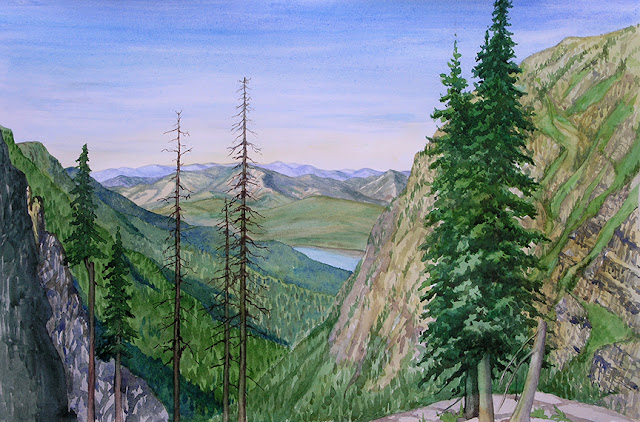 |
| Mt. Edwards from Comeau Pass |
Clouds began to gather on the west as I ate my lunch. My lunch companion's friends arrived as we were finishing, and he put his backpack on. The young men took off right away while I lingered a bit taking in my surroundings. From here I could see several expanses of snow fields zigzagging across rocky ridges. The trail had disappeared, but rock cairns piled every so often on the ridges marked the way.
 |
| Stone cairns marking the trail |
A group of mountain goats were looking for grazing just below the pass, and scurried away as I approached. I wondered if they used the stairs at Comeau Pass to get over the pass (the grizzly earlier in the week had used the stairs), or if they preferred to simply walk on the rocks--either would be easy for them.
 |
| Mountain goats below Comeau Pass |
 |
| Mountain goats |
A group of hikers returning from the glacier passed me on a snow field, and the young men hiking ahead of me were so far ahead I soon lost sight of them. Looking down the hill, the array of small lakes dotting the snow fields, and the peaks below were gorgeous.
 |
| Hikers going to Sperry Glacier |
 |
| Trail to the glacier |
 |
| View to the north |
 |
| Lakes near Sperry Glacier |
Even the lichens on the rocks were fascinating: bright orange-red and yellow-green. I followed the rock cairns as best I could, but somehow I must have veered off-course, and when I finally came around a promontory, I saw that I was a couple hundred feet below the glacier. I started back uphill too close to a rocky outcrop, and before I realized it, my foot had sunk down into an undercut in the snow. Fortunately it went straight down, and I didn't twist anything, just sank into the snow up to my crotch. That shook me up--what if I'd sprained or broken an ankle? How would I get back on my own? I was probably crazy to be hiking alone, at my age.
 |
| Hikers on Sperry Glacier |
The sky was becoming increasingly cloudy. It looked as if a storm was coming, the question was how long before it would get here. After seeing the ferocity of the first storm a few days earlier, the last thing I wanted was to have to go over Comeau Pass during a storm--on those exposed ridges one could easily be hit by lightning.
It was about two o'clock and the young men who had gone ahead of me and played on the glacier were now coming back. I gauged how much more time it would take me to reach the plaque that marked the glacier, and it was more than I wanted to chance--my remaining energy was better invested on getting back over the pass before the storm hit.
 |
| With Sperry Glacier in the background |
 |
| Near Sperry Glacier |
Reluctantly, I decided to settle for a couple of photos standing in front of Sperry Glacier, which my young friend took, and then start back. Near the pass I encountered a family group with children who thought they had reached the glacier, and I explained that they had about another half-mile to go to get there. They continued forward, though I wouldn't have advised it.
 |
| Going down the staircase |
I managed to reach the staircase at Comeau Pass just ahead of the storm. Once below, as I ran downhill on the trail, the winds buffeting the exposed ridges were so strong they almost knocked me down,--I would have fallen, except for my hiking poles holding me up. I stumbled down the trail as fast as I could while the first drops of rain fell. As soon as I reached a less exposed area, I stopped to pull on my jacket and put the hood up, and continued hurrying down to lower altitudes.
The deluge I had expected didn't materialize, or the lightning, only a bit of rain, not enough to soak through. Yet the trail had become like a stream in places, the water tumbling down in torrents over the rocks. The flow of the waterfalls seemed to have increased, the sound of the water and wind overwhelming.
 |
| Akaiyan falls during the storm. |
As I descended the storm passed, and my attention turned to the plants--they seemed to thrive with the periodic soaking, whether from snow melt or rain. I stopped to photograph some of them before heading home to Sperry Chalet.
 |
| Yellow mountain heath (Phyllodoce glanduliflora) |
 |
| Alpine wildflowers and mosses |
 |
| The storm over Sperry Chalet |





















































